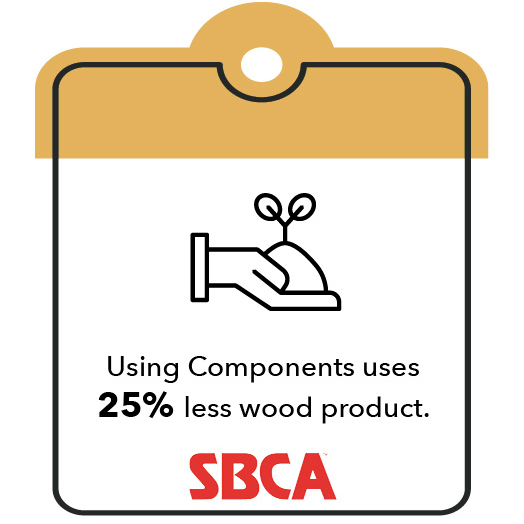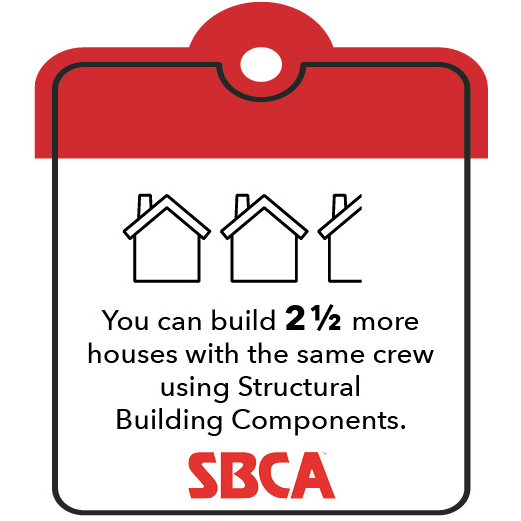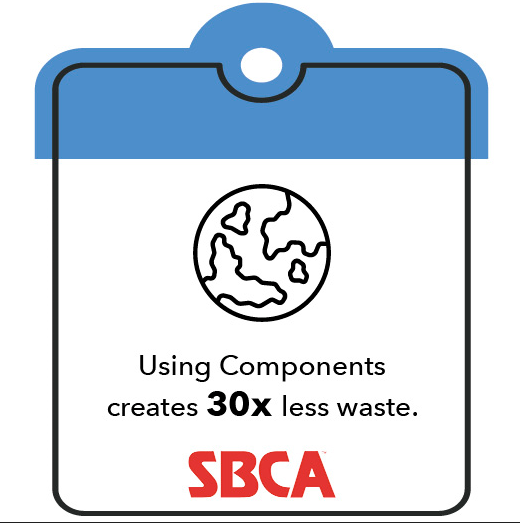BCSI Paves Way for Beneficial Framing Methodology
Originally Published by: SBCA Magazine — July 18, 2023
SBCA appreciates your input; please email us if you have any comments or corrections to this article.
 Any project stands to gain where structural building components are a viable solution per code requirements, including single-family production home communities, build-to-rent developments, luxury custom design homes, accessory dwelling units (ADU’s), multi-family apartments, student-living units, and senior assisted living complexes. Simply put, the value far outweighs the challenges. In fact, many of the preconceived hurdles to this method of construction are avoidable with the proper guidance, team, and practiced implementation, much of which is outlined in the Building Component Safety Information (BCSI) Handbook.
Any project stands to gain where structural building components are a viable solution per code requirements, including single-family production home communities, build-to-rent developments, luxury custom design homes, accessory dwelling units (ADU’s), multi-family apartments, student-living units, and senior assisted living complexes. Simply put, the value far outweighs the challenges. In fact, many of the preconceived hurdles to this method of construction are avoidable with the proper guidance, team, and practiced implementation, much of which is outlined in the Building Component Safety Information (BCSI) Handbook.
The core advantages of a system built componentized structure that leverages off-site manufacturing and on-site assembly to create a variety of residential building project types are greater safety, reduced risk, higher quality and continuity, increased cost savings and ROI, faster time-to-market, environmental and energy efficiencies, and a lower labor burden.
 Greater Safety & Reduced Risk | The BCSI Handbook is a crucial tool for ensuring the physical safety of on-site workers. By following the guidelines in the guidebook, construction personnel reduce the risk of accidents and injuries, leading to safer construction sites and healthier employees. This not only protects the workers but also reduces the risk to developers, builders, investors, and designers, engineers, and end users.
Greater Safety & Reduced Risk | The BCSI Handbook is a crucial tool for ensuring the physical safety of on-site workers. By following the guidelines in the guidebook, construction personnel reduce the risk of accidents and injuries, leading to safer construction sites and healthier employees. This not only protects the workers but also reduces the risk to developers, builders, investors, and designers, engineers, and end users.
In addition to the handbook, job-site packages and section summary sheets are valuable resources for component manufacturers (CMs). Including job-site packages as a standard practice when delivering components, CMs are adding an additional layer of safety and risk mitigation to their practices. However, the value of these resources doesn't come from simply possessing them. The installation crew and project managers must keep them accessible for frequent reference and review as part of their standard assembly and installation practices.
 Higher Quality & Continuity | Building with components offers several advantages in terms of quality. The science behind triangulation makes trusses stronger and more capable than traditional stick frame building methods. Trusses have a longer span and do not require load-bearing columns, allowing for more design flexibility. The open webs for both roof and floor trusses allow MEP Subcontractors to install plumbing, piping, duct, electrical equipment, etc., without having to make any cuts or adjustments to the structure after its frame.
Higher Quality & Continuity | Building with components offers several advantages in terms of quality. The science behind triangulation makes trusses stronger and more capable than traditional stick frame building methods. Trusses have a longer span and do not require load-bearing columns, allowing for more design flexibility. The open webs for both roof and floor trusses allow MEP Subcontractors to install plumbing, piping, duct, electrical equipment, etc., without having to make any cuts or adjustments to the structure after its frame.
The consistency in quality that comes from off-site manufacturing vs on-site plan interpretation, cutting, nailing, gluing, and screwing stick by stick is another significant advantage. This consistency allows for less skilled craftmanship, meaning that contractors and stakeholders can bring on workers at lower wage rates while maintaining and in many cases improving the quality and consistency of the final product.
 Increased Cost Saving & ROI | Higher quality doesn't always mean higher cost, but it does mean higher value. Using components and leveraging the BCSI Guide when handling, installing, bracing, and erecting structures takes less manpower at lower skill leading to lower wage rates and can be done much faster than traditional building leading to significant cost reductions and increased savings that translate to the bottom line.
Increased Cost Saving & ROI | Higher quality doesn't always mean higher cost, but it does mean higher value. Using components and leveraging the BCSI Guide when handling, installing, bracing, and erecting structures takes less manpower at lower skill leading to lower wage rates and can be done much faster than traditional building leading to significant cost reductions and increased savings that translate to the bottom line.
Faster Time-to-Market | Component-built homes are framed faster than stick-framed homes, which translates to savings all around. Being able to fully frame and enclose a structure quickly allows the other trades, Mechanical, Plumbing, Electrical, etc., to begin their work more expediently without weather delays such as snow, extreme heat, rain, high winds, etc.
 Environmental & Energy Efficiencies | Building with components also has a lower environmental impact. Less on-site waste means less wasted material. Shorter turnaround times and precision delivery and installation mitigate the environmental impact of transportation, foot traffic, and carbon emissions.
Environmental & Energy Efficiencies | Building with components also has a lower environmental impact. Less on-site waste means less wasted material. Shorter turnaround times and precision delivery and installation mitigate the environmental impact of transportation, foot traffic, and carbon emissions.
Lower Labor Burden | The labor shortage has impacted nearly every sector and industry on a global scale. However, the construction industry was bearing the brunt of deep industry shortages well before sectors such as retail, hospitality, healthcare, and so on. One of the reasons the workforce labor shortage is so prevalent across the built environment is due to the lack of available training and education programs for skill trade workers like Framers. The BCSI is a straightforward and scalable guide that allows entry-level learners and workers across the various stakeholders of the project to learn, understand, and implement their work and learnings efficiently, accurately, and safely without cutting corners, cultivating bad habits through workarounds, improper teachings, or conflicting instructions.
At the end of the day the BCSI Handbook is more than resource, it’s a necessity with something for everyone involved in the residential building industry. By adhering to the best practices outlined in the handbook, stakeholders can improve their processes, increase the quality of their output, and gain a competitive edge within their sector of the built environment. The adoption and proper implementation of structural building components drives a higher standard of home, rented, or owned anywhere homes are built, collectively improving an industry in need of accessible, attainable, and affordable, and achievable innovations.
